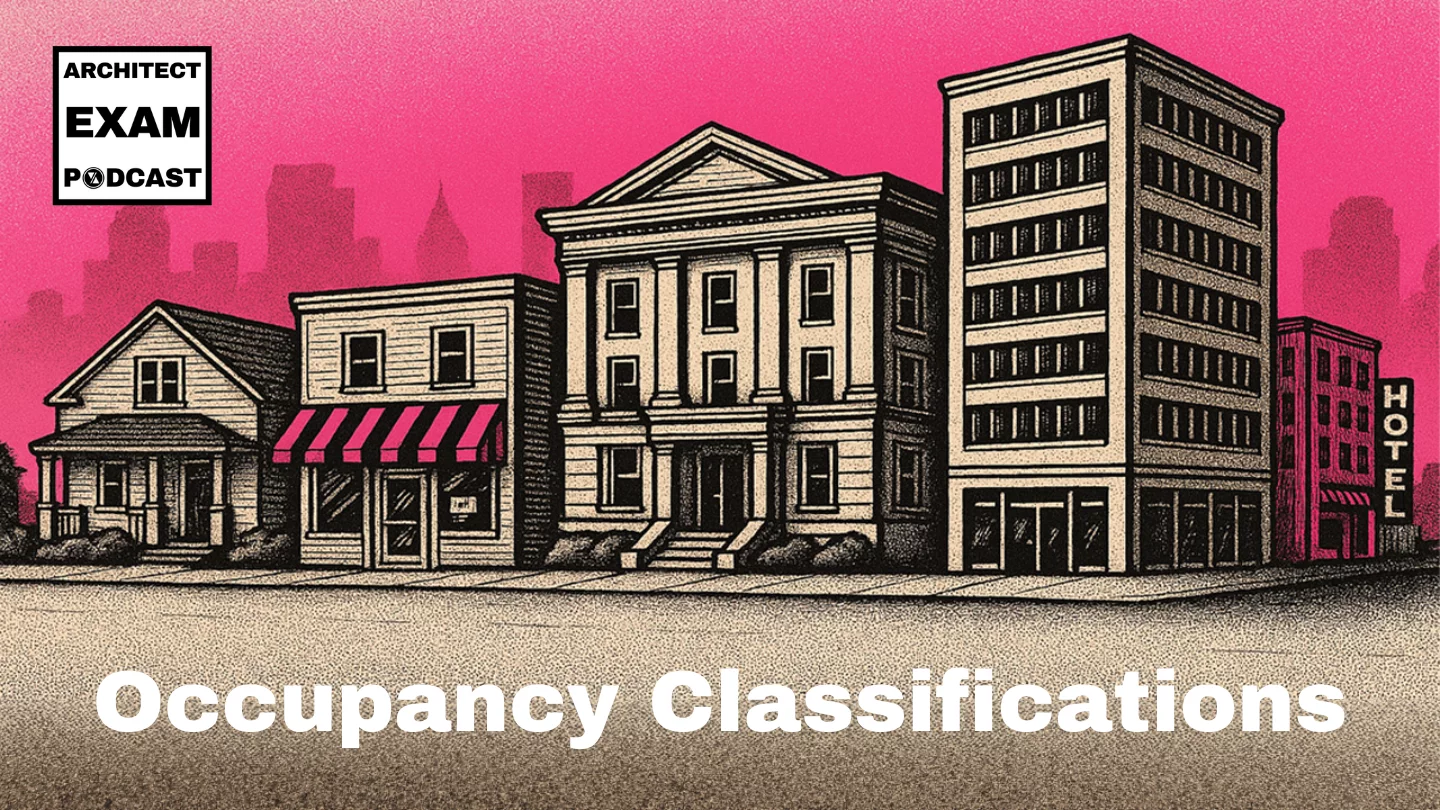Mastering occupancy classifications are essential for ARE success. This guide breaks down IBC’s classification system and shows how it affects design, code compliance, and safety. Learn to confidently classify any project and avoid costly compliance issues.
This podcast is also available on YouTube, Spotify, and Apple Podcasts
The Building Code’s Foundation: Why Occupancy Classification Matters
Have you ever wondered why a nightclub needs more exits than an office building of the same size? Or why a hospital requires different fire protection systems than an apartment building? The answer lies in occupancy classification.
Occupancy classification is the cornerstone of building code compliance and the first critical decision that shapes virtually every aspect of your building design. Think of it as the DNA of your project – it contains the essential code information that will influence everything from how tall your building can be to how many exits you’ll need.
As an ARE candidate, understanding occupancy classification isn’t just about passing an exam – it’s about developing the fundamental knowledge that will guide your design decisions throughout your career. Let’s demystify this essential concept and see why it matters so much.
What Is Occupancy Classification?
At its core, occupancy classification is simply how the International Building Code (IBC) categorizes buildings based on their primary use. This classification system exists because different types of buildings pose different risks to their occupants based on factors like:
- How many people typically occupy the space
- What activities take place inside
- Whether people are awake or asleep
- How familiar occupants are with the building
- What kind of materials or hazards might be present
Think about it like this: a theater packed with hundreds of unfamiliar people in the dark has very different safety needs than a warehouse with just a few workers who know the building well. Occupancy classification is the code’s way of recognizing these differences and applying appropriate safety standards to each building type.
The IBC currently defines 10 major occupancy groups (A through U, with some letters skipped), each with its own specific requirements. These classifications serve as the gateway to all other code provisions – once you know a building’s occupancy, you can determine the appropriate requirements for construction type, fire protection, means of egress, and more.
Why Occupancy Classification Is Critical for Architects
Getting the occupancy classification right is one of the most important steps in the design process, a critical quality assurance measure that prevents problems before they occur, and here’s why:
1. It Sets Limits on Building Height and Area
The allowable height and area of your building are directly tied to its occupancy classification. A building classified as High Hazard (Group H) will have much stricter limitations than one classified as Business (Group B), even if they use the same construction type. This is because the potential consequences of a fire or other emergency are much greater in high-hazard occupancies.
2. It Determines Egress Requirements
How many exits do you need? How wide should they be? How far can someone travel to reach an exit? All these critical life-safety questions are answered based on occupancy classification. For example, an Assembly occupancy (like a theater) requires more exits and shorter travel distances than a Business occupancy of the same size because it has more occupants who may panic in an emergency.
3. It Drives Fire Protection Requirements
Occupancy classification has a major impact on whether you need sprinklers, fire alarms, smoke control systems, or fire-rated separations. Some occupancies, like Institutional (Group I) healthcare facilities, require comprehensive fire protection systems because their occupants may be unable to evacuate on their own, while others might have less stringent requirements.
4. It Influences Accessibility Provisions
While accessibility is required in most buildings, the specific requirements can vary by occupancy. For instance, a Mercantile occupancy (Group M) needs to ensure accessible routes throughout public spaces, while a Factory (Group F) might have exceptions for certain employee-only areas.
5. It Can Make or Break Your Project
Misclassifying a building can lead to serious problems. If you design to the wrong occupancy classification, you might:
- Create a building that’s unsafe for its intended use
- Design a structure that fails to meet code requirements
- Face costly redesigns during the permit review process
- Encounter difficulties when trying to repurpose a building in the future
In short, occupancy classification sets the foundation for your entire design approach. Get it right, and everything else falls into place. Get it wrong, and you could be fighting an uphill battle throughout the project, including increased construction contingency costs to address code compliance issues.
The 10 Major Occupancy Groups in the IBC
Let’s explore each of the major occupancy groups defined by the IBC, with practical examples and key information you should know for both the ARE and real-world practice.
Group A: Assembly
Definition: Places where people gather in groups for entertainment, dining, worship, recreation, or waiting for transportation.
Common Examples:
- A-1: Theaters, concert halls, and TV studios with an audience
- A-2: Restaurants, nightclubs, and food courts
- A-3: Libraries, museums, and places of worship
- A-4: Indoor sporting events with spectator seating
- A-5: Outdoor stadiums and grandstands
Key Safety Concerns:
- High occupant loads (many people in one space)
- Occupants who may be unfamiliar with exits
- Potential for panic during emergencies
- Possible low lighting conditions
- Complex seating arrangements or fixed seating
Remember This: Not every space where people gather is classified as Assembly. The “50 person rule” is crucial—if fewer than 50 people occupy a space, it’s often classified as Group B (Business) instead of Group A. This is a common exam question trap!
Group B: Business
Definition: Places used for office, professional, or service-type transactions, including educational facilities above the 12th grade.
Common Examples:
- Office buildings
- Banks and financial institutions
- Medical offices (outpatient)
- Post offices
- College and university classrooms
- Professional services (architects, attorneys, etc.)
Key Safety Concerns:
- Moderate occupant loads
- Electrical and IT equipment fire hazards
- Paper storage creating potential fuel load
- Occupants generally familiar with surroundings
Remember This: One surprising inclusion in Group B is higher education facilities (colleges and universities). Even though they’re educational in nature, they’re classified as Business, not Educational (Group E). This is because adult students are considered capable of self-preservation without special assistance.
Group E: Educational
Definition: Buildings used for educational purposes through the 12th grade, as well as daycare facilities for children older than 2½ years with 5+ children.
Common Examples:
- Elementary, middle, and high schools
- Preschools
- Daycare facilities (with age/size limitations)
- After-school programs
Key Safety Concerns:
- Occupants may need guidance during emergencies
- Children who don’t recognize danger
- Multiple age groups with different capabilities
- High occupant loads during school hours
Remember This: The age cut-off is critical! Daycare facilities for children under 2½ years of age are classified as Institutional (Group I-4), not Educational, because very young children need more assistance during emergencies. This distinction frequently appears on the ARE.
Group F: Factory and Industrial
Definition: Buildings used for manufacturing, assembly, fabrication, or processing of products or materials.
Common Examples:
- F-1 (Moderate Hazard): Woodworking, clothing manufacturing, printing operations
- F-2 (Low Hazard): Brick manufacturing, non-alcoholic beverages, ice production
Key Safety Concerns:
- Industrial processes with potential hazards
- Machinery and equipment risks
- Moderate occupant loads (workers)
- Noise that might obscure alarms
- Potentially larger spaces and longer exit travel distances
Remember This: The distinction between F-1 and F-2 is based on the combustibility of the materials being processed. F-1 involves materials that can burn (like wood or fabric), while F-2 involves non-combustible materials (like metal or glass). If the quantities of hazardous materials exceed certain thresholds, the classification changes to Group H (High Hazard).
Group H: High Hazard
Definition: Buildings that involve the manufacturing, processing, or storage of materials that constitute a high fire, explosion, or health hazard.
Common Examples:
- H-1: Facilities that risk detonation (explosives manufacturing)
- H-2: Facilities with accelerated burning materials (hydrogen storage)
- H-3: Facilities with materials that support combustion (flammable solids/liquids)
- H-4: Facilities with health hazards (toxic or corrosive materials)
- H-5: Semiconductor fabrication using hazardous production materials
Key Safety Concerns:
- Extreme fire or explosion risks
- Toxic or harmful substance exposure
- Potential for rapid fire spread
- Danger to firefighters and emergency responders
- Potential community-wide impact during incidents
Remember This: Group H has the most subdivisions and the most restrictive requirements of any occupancy group. The classification is based on the quantity and type of hazardous materials present—small quantities might be permitted as incidental uses in other occupancies, but once thresholds are exceeded, Group H classification is triggered.
Group I: Institutional
Definition: Buildings where people are cared for or living in a supervised environment and have limited ability to self-preserve in an emergency.
Common Examples:
- I-1: Assisted living facilities, group homes (occupants can respond to emergencies)
- I-2: Hospitals, nursing homes (occupants need assistance to respond)
- I-3: Detention centers, jails, prisons (occupants are restrained)
- I-4: Day care facilities for more than five children under 2½ years old
Key Safety Concerns:
- Occupants may be incapable of self-evacuation
- 24-hour operation in many cases
- Secure environments that might impede egress
- Special needs populations
- Medical equipment and oxygen use (I-2)
Remember This: The key factor that makes an occupancy “Institutional” is the inability of occupants to self-preserve—either due to medical conditions, age, or restraint. This is why a hospital is I-2 but a medical office building is B, and why a daycare for infants is I-4 but a school for older children is E.
Group M: Mercantile
Definition: Buildings used for the display and sale of merchandise accessible to the public.
Common Examples:
- Retail stores
- Department stores
- Shopping malls
- Markets
- Showrooms
- Drug stores
Key Safety Concerns:
- Variable occupant loads (can be very high during sales)
- Occupants unfamiliar with exits
- High fuel loads from merchandise
- Display fixtures that can impede egress
- Constantly changing layouts in some stores
Remember This: The distinction between Mercantile (M) and Business (B) can sometimes be confusing. The key difference is that Mercantile primarily involves displaying and selling goods to the public, while Business involves providing services or conducting transactions. A showroom where customers come to purchase items is Group M; an office where consultations happen is Group B.
Group R: Residential
Definition: Buildings or portions of buildings used for sleeping purposes when not classified as Institutional.
Common Examples:
- R-1: Hotels, motels, boarding houses (transient)
- R-2: Apartment buildings, dormitories (permanent)
- R-3: One and two-family dwellings, townhouses
- R-4: Assisted living facilities with 5-16 residents (capable of self-preservation)
Key Safety Concerns:
- Occupants likely to be asleep during emergencies
- Cooking activities creating fire risks
- Personal belongings creating fuel load
- Mix of common spaces and private units
- Potential for children, elderly, or disabled occupants
Remember This: The distinction between R-1 and R-2 is based on length of stay: R-1 is for transient occupancy (less than 30 days, like hotels), while R-2 is for permanent residents (apartments, dorms). R-4 is sometimes confused with I-1, but the key difference is scale—R-4 is smaller (5-16 residents) while I-1 is larger.
Group S: Storage
Definition: Buildings used for storage purposes that are not classified as hazardous.
Common Examples:
- S-1 (Moderate Hazard): Furniture warehouses, general storage, books, paper products
- S-2 (Low Hazard): Metal parts storage, parking garages, non-combustible materials
Key Safety Concerns:
- Low occupant loads but high fuel loads
- Potential for rapid fire spread through stored materials
- Longer distances to exits in large warehouses
- Storage rack configurations affecting sprinkler effectiveness
- Limited surveillance in rarely visited areas
Remember This: Parking garages are classified as S-2 (Low-Hazard Storage), not as a vehicular-related occupancy. This is because they primarily serve as storage for vehicles, and the vehicles themselves are mostly non-combustible (despite containing fuel). Open parking garages have special provisions allowing larger areas and reduced fire ratings due to natural ventilation.
Group U: Utility and Miscellaneous
Definition: Buildings and structures of an accessory character or not classified in any specific occupancy.
Common Examples:
- Agricultural buildings
- Barns
- Carports and detached garages
- Greenhouses
- Sheds
- Tanks
- Towers
- Fences higher than 6 feet
Key Safety Concerns:
- Generally low occupant loads
- Varied uses and potential hazards
- Often unoccupied or infrequently occupied
- May contain equipment or animals rather than people
Remember This: Group U is essentially a catch-all for accessory structures that don’t fit neatly into other categories. Don’t assume a storage shed is Group S—small sheds are typically Group U. Group U structures are generally not meant for human occupancy, at least not for extended periods.
Common Misconceptions About Occupancy Classification
Even experienced designers sometimes misunderstand certain aspects of occupancy classification. Let’s clear up some common misconceptions:
Myth: Every Room Gets Its Own Classification
Reality: Occupancy classification typically applies to fire areas or the entire building, not to individual rooms. Small supporting spaces (like storage closets in an office) don’t get their own separate classification—they’re considered accessory to the main occupancy.
For example, a small storage room within an office building doesn’t become Group S; it remains part of the Group B occupancy. However, if a storage area exceeds a certain percentage of the floor area, it might need to be considered a separate occupancy.
Myth: All Gathering Spaces Are Assembly (Group A)
Reality: As we’ve seen, the “50 person rule” means that gathering spaces with fewer than 50 occupants are often classified as Group B, not Group A. This means a small conference room or café with 30 seats would be considered part of a Business occupancy, not an Assembly occupancy.
Myth: Educational Includes All Schools
Reality: Group E only covers educational facilities through the 12th grade. Higher education (colleges and universities) falls under Group B, even though they’re educational in nature. This distinction reflects the different capabilities of adult students compared to children.
Myth: Small Storage Areas in Offices Are Group S
Reality: Small storage areas within larger occupancies are typically considered accessory to the main occupancy, not separate occupancies. So a file storage room in an office building remains Group B, not Group S, as long as it’s supporting the main function of the building.
Myth: Mixed-Use Always Requires Fire Separation
Reality: The IBC provides multiple options for dealing with mixed-use buildings. While fire-rated separations between different occupancies is one approach, non-separated occupancies are also permitted if the building complies with the most restrictive requirements of each occupancy.
Understanding Mixed-Use Occupancies
Many buildings serve multiple purposes, creating mixed-use scenarios. The IBC provides three main approaches to handling these situations:
1. Accessory Occupancies
What they are: Occupancies that are ancillary to the main occupancy and occupy only a small portion of the building (generally less than 10% of the floor area).
How they work: Accessory occupancies are permitted to be considered part of the main occupancy for applying code requirements. They don’t need to be separated or individually classified.
2. Separated Occupancies
What they are: Different occupancies within a building that are physically separated from each other by fire-resistance-rated construction.
How they work: Each separated portion of the building must comply with the code requirements for that specific occupancy. Fire barriers create boundaries between different occupancy areas.
3. Non-Separated Occupancies
What they are: Different occupancies within a building that are not separated by fire-resistance-rated construction.
How they work: The entire building must comply with the most restrictive provisions of each of the occupancies present. This often results in applying the stricter requirements throughout.
Common Required Separations
When using the separated occupancies approach, the IBC provides a table specifying the required fire-resistance ratings between different occupancies. Some common separations include:
- Between Group A and Group R: 1-2 hour separation
- Between Group B and Group R: 1 hour separation
- Between Group H and most other occupancies: 1-4 hour separation
The specific ratings depend on whether the building is sprinklered and the specific sub-classifications involved.
Occupancy Classification on the ARE Exam
The ARE frequently tests knowledge of occupancy classification because it’s such a fundamental concept. Here’s what to expect and how to prepare:
Common Test Formats
- Scenario questions asking you to identify the correct occupancy for a described building
- Questions about required separations between occupancies
- Problems involving changes of occupancy in renovation projects
- Situations involving mixed occupancies and how to handle them
Approach to Solving Occupancy Problems
- Identify the primary use of the space or building
- Consider special factors like:
- Number of occupants (especially the 50-person threshold for Assembly)
- Age of occupants (particularly for Educational vs. Institutional)
- Ability of occupants to self-preserve (for Institutional)
- Types of materials stored or used (for Factory, Storage, or High Hazard)
- Check for mixed occupancies and determine if they should be accessory, separated, or non-separated
- Apply the appropriate requirements based on the occupancy classification
Common Traps to Avoid
- Watch for occupant counts in Assembly vs. Business scenarios
- Pay attention to age groups in Educational vs. Institutional questions
- Don’t ignore material quantities in Factory vs. High Hazard scenarios
- Be careful with residential subcategories (R-1 through R-4)
- Don’t overclassify accessory spaces as separate occupancies
Conclusion: Why Understanding Occupancy Classification Matters
Occupancy classification isn’t just a technical exercise or a box to check during design—it’s the foundation of building safety and code compliance. As an ARE candidate and future architect, understanding this concept thoroughly will:
- Help you make informed design decisions from the start of a project
- Allow you to navigate code requirements more efficiently
- Prepare you for questions on the ARE exam (which frequently test this knowledge)
- Enable you to advise clients on feasibility and code implications
- Empower you to create safer buildings for all occupants
When approaching this topic on the exam, remember to focus on the key distinguishing factors for each occupancy type, particularly age thresholds, occupant counts, and the ability of occupants to self-preserve. These details are frequently tested and often determine the difference between two possible classifications.
For additional practice, try our occupancy classification practice questions in the Young Architect ARE Prep materials, where you can test your knowledge with real-world scenarios and exam-style questions.
Additional Resources
- Young Architect Codes 101 course: Comprehensive coverage of building codes with 180 practice questions
- International Building Code, Chapter 3: The official source for occupancy classification definitions
Remember: Understanding the “why” behind occupancy classification is more valuable than memorizing definitions. Focus on the risk factors and safety principles, and the classifications will make intuitive sense.
Looking for more resources to help with your ARE exam preparation? Visit Young Architect Academy for comprehensive resources designed to help you master building codes, occupancy classifications, and pass your exams with confidence.
{
“@context”: “https://schema.org”,
“@type”: “BlogPosting”,
“headline”: “Occupancy Classifications Simplified: Navigating the IBC’s Key Categories”,
“description”: “Unlock the importance of occupancy classifications for building design and code compliance. Master IBC classifications with this guide.”,
“datePublished”: “2024-07-05T08:00:00-04:00”,
“dateModified”: “2024-07-05T08:00:00-04:00”,
“author”: {
“@type”: “Person”,
“name”: “Michael Riscica”,
“url”: “https://youngarchitect.com/about/”
},
“publisher”: {
“@type”: “Organization”,
“name”: “Young Architect Academy”,
“logo”: {
“@type”: “ImageObject”,
“url”: “https://academy2.youngarchitect.com/wp-content/uploads/2025/04/YAA-email-logo.jpg”
}
},
“mainEntityOfPage”: {
“@type”: “WebPage”,
“@id”: “https://academy2.youngarchitect.com/occupancy-classification”
},
“image”: “https://i.ytimg.com/vi/VzbevYrOXQ0/maxresdefault.jpg”,
“video”: {
“@type”: “VideoObject”,
“name”: “009 – Occupancy Classifications Simplified”,
“description”: “Video version of the Architect Exam Podcast episode on occupancy classifications”,
“thumbnailUrl”: “https://i.ytimg.com/vi/VzbevYrOXQ0/maxresdefault.jpg”,
“uploadDate”: “2024-07-05T08:00:00-04:00”,
“duration”: “PT16M45S”,
“contentUrl”: “https://youtu.be/VzbevYrOXQ0”,
“embedUrl”: “https://www.youtube.com/embed/VzbevYrOXQ0”
},
“audio”: {
“@type”: “PodcastEpisode”,
“name”: “009 – Occupancy Classifications Explained”,
“url”: “https://podcasts.apple.com/us/podcast/009-occupancy-classifications-explained-building-code/id1802940467?i=1000701573490”,
“partOfSeries”: {
“@type”: “PodcastSeries”,
“name”: “Architect Exam Podcast”,
“@id”: “https://academy2.youngarchitect.com/architect-exam-podcast#podcast”
},
“datePublished”: “2024-07-05T08:00:00-04:00”
},
“hasPart”: {
“@type”: “DigitalDocument”,
“name”: “IBC Occupancy Classifications Study Guide – FREE ARE 5.0 PDF”,
“description”: “Free 2-page occupancy classifications study guide for ARE 5.0 exam prep. Master all IBC categories and NCARB requirements.”,
“encodingFormat”: “application/pdf”,
“educationalUse”: “Study Guide”,
“learningResourceType”: “Supplemental Material”,
“isAccessibleForFree”: true,
“creativeWorkStatus”: “Published”
}
}



